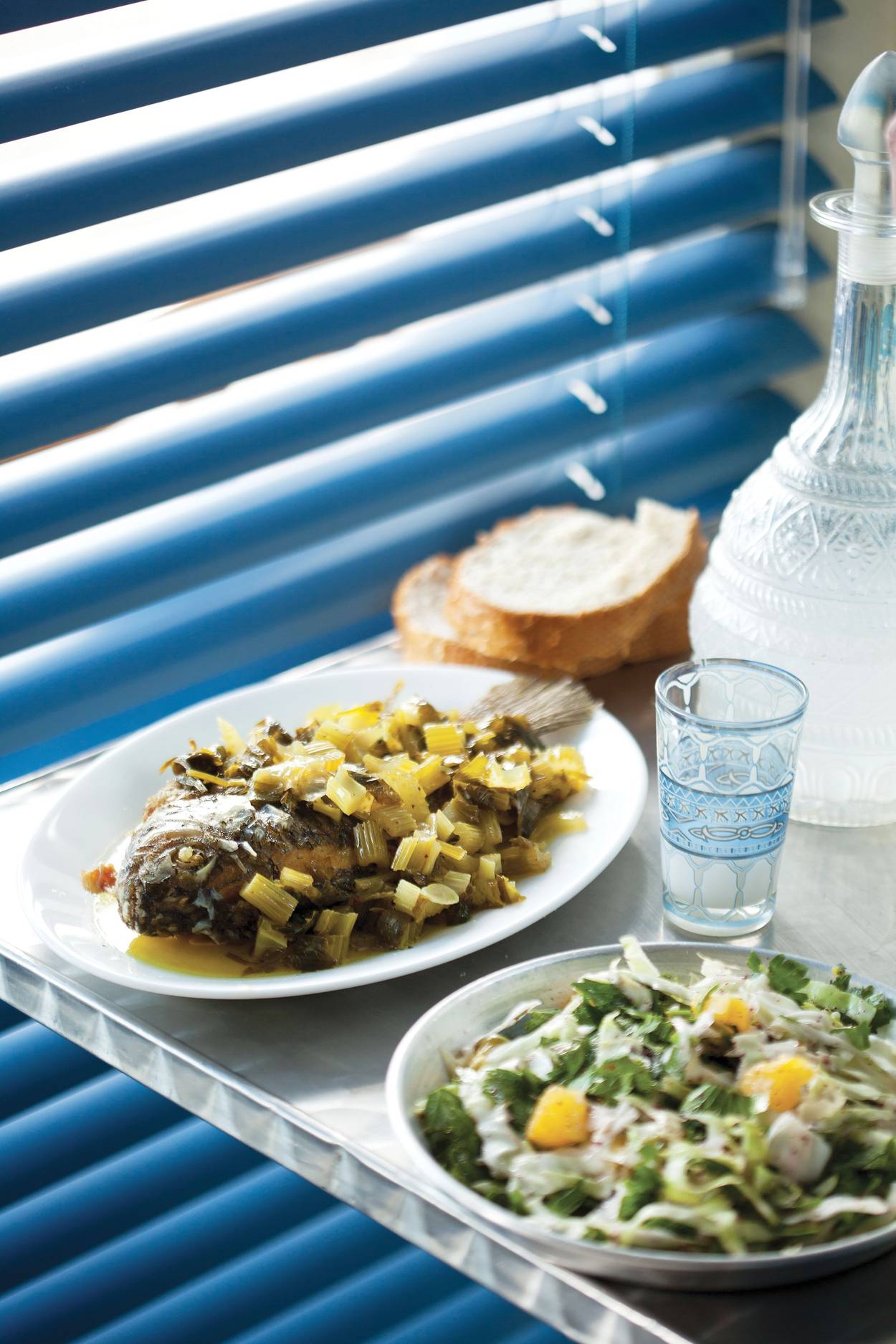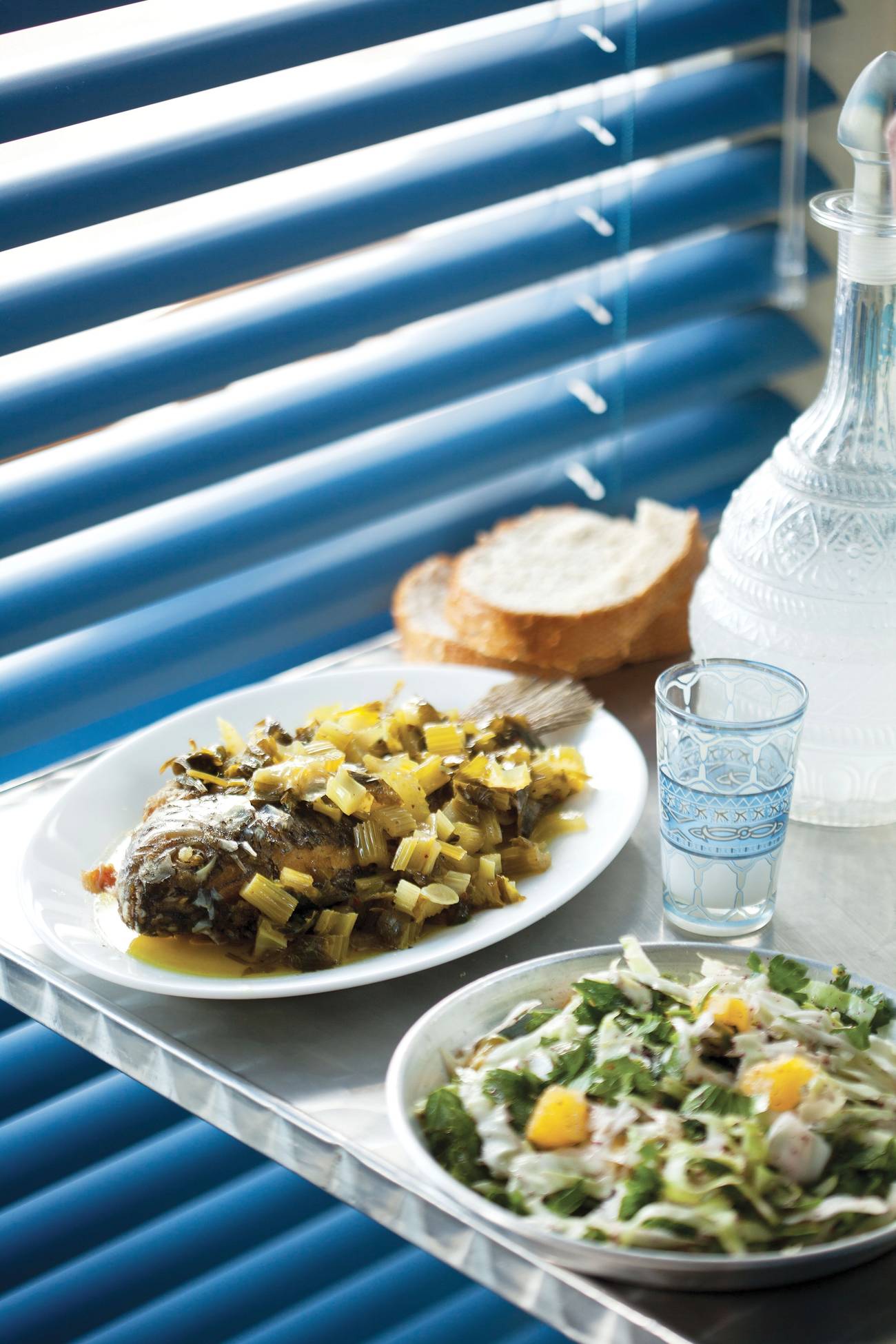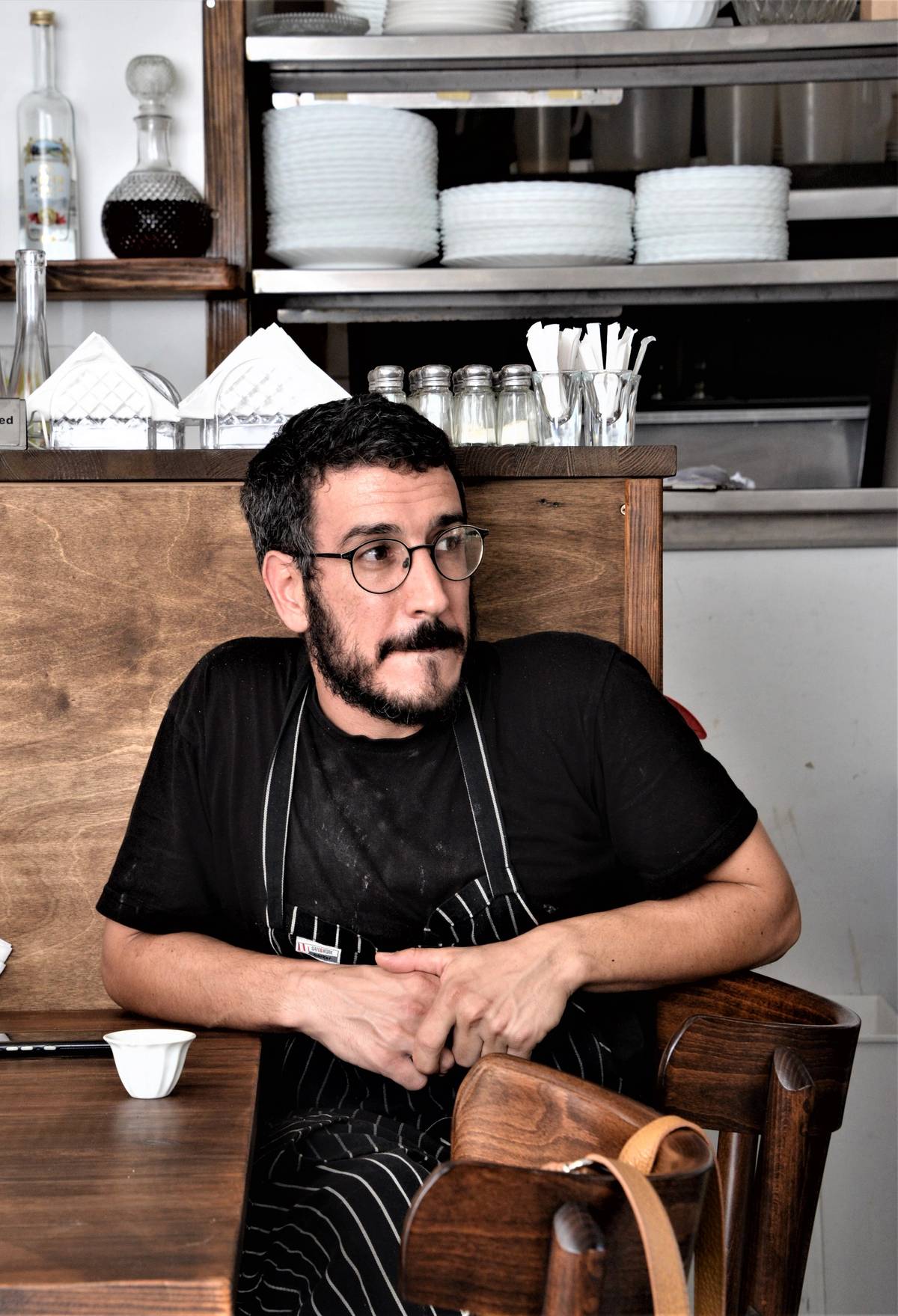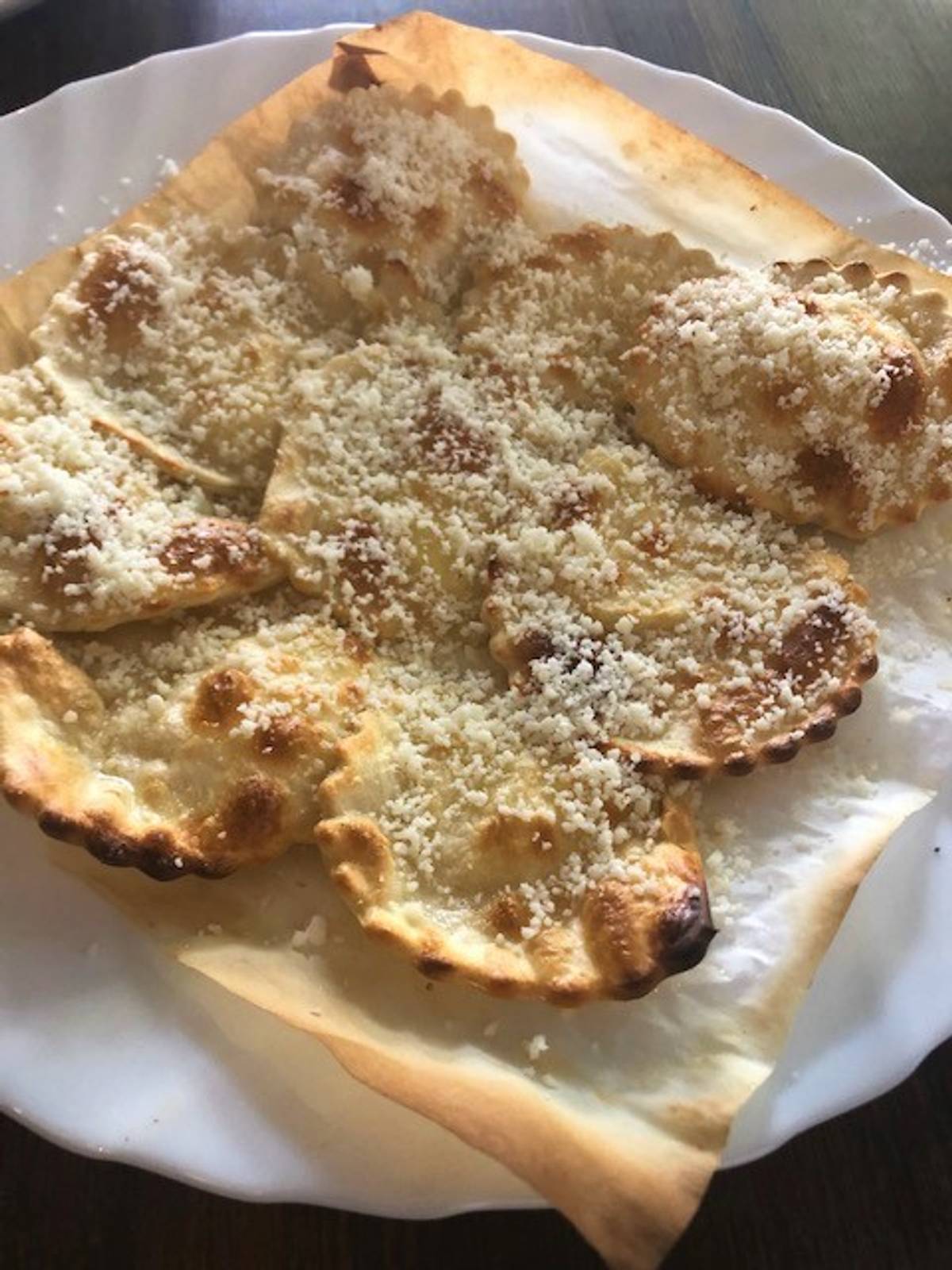The Lost Taste of Tiberias
The ancient Israeli city’s distinctive culinary heritage draws from Arabic, Sephardic, and Ashkenazi traditions




In downtown Tiberias, not far from the Kinneret lakeshore, there is a newish open-air shopping plaza. Reminiscent of an Italian piazza, it is built from the black basalt stone that is typical of the area, and surrounded by a shaded portico. Unlike Italian piazzas, there are neither fountains nor equestrian statues; instead, the piazza is dominated by a mosque. Defunct and encircled by a fence, the partially ruined building looks imposing in a kind of ominous way. “Tiberians swear that the Waqf,” an organization in charge of preserving and maintaining Muslim holy sites, “put a curse on the place, because of what Jews did to Arabs in 1948,” Abigail Aharon, chef-owner of a nearby restaurant, told me. “Look, it is so pretty, and the location is fantastic, yet most shops are closed, and trust me, those that are still open will soon go under.” An elderly woman, an acquaintance of Aharon, passed by, and Aharon called upon her to corroborate her theory, but she waved her off: “Forget the curse,” said the woman, “people in this city just don’t have enough money to shop”.
This conversation, which took place about six years ago, tells in a nutshell the sad story of Tiberias today. It was not always like that. I remember my first visit there, in the mid-1970s, shortly after I immigrated to Israel. In those days, Tiberias was a popular, exotic resort town with a magnificent past and promising future. Israelis and tourists soaked in the medicinal hot springs, danced through the night in the discos, ate freshly caught fish in waterfront restaurants, or raced the lake’s placid waters on motorboats and water skis.
Seen from afar, the city retains some of its magic, especially by night, when the moon shines over the lake and the city lights, which glide down all the way to the shore, glisten like a huge diamond necklace. A closer look tells a different story: decades of urban neglect, ugly commercial buildings, and skeletons of failed businesses. Here and there, one can spot fragments of the ancient city wall, stunning vistas of the lake, and quaint houses of old Tiberias. Built from black stone, their porches ablaze with bougainvillea, these enclaves of beauty make the cityscape even more heartbreaking.
“The city is in a coma,” Aharon said with a sigh as we sat down for lunch at her restaurant, Abigail’s Kitchen (located near the cursed plaza, but facing the opposite direction, just in case). “Many Tiberians believe that once Arabs left, or rather were made to leave, during the War of Independence in 1948, the city was never the same.” For Aharon, a chef, an activist, and a 14th-generation Tiberian, preserving the heritage of her hometown has been a lifetime project. In her small homey restaurant, over a plate of rice-stuffed zucchini in lemony sauce and a glass of arak, I listened to her fascinating and poignant tales of Tiberias and its unique food culture.
Tiberias was built during the first century CE, and named after the reigning Roman Emperor Tiberius. After the destruction of the Temple in Jerusalem, Tiberias became one of the centers of Jewish life and learning. The Sanhedrin moved there, as did many important yeshivas. Some of the most prominent Jewish sages are buried in Tiberias, including Maimonides. The Jewish community grew dramatically in the 16th century, when the Ottoman ruler Suleiman the Magnificent granted a long-term lease of Tiberias and its surroundings to Dona Gracia Nasi, a renowned Jewish financier and philanthropist, who actively encouraged immigration of Sephardic Jews to Tiberias and Safed. In the late 18th century, a few hundred Hasidic Jews from Poland arrived in the city, which by that time had regained its status as the center of Jewish study in the Land of Israel.
Tiberias was a walled city, and settlement was allowed only within the walls. As the population grew, living conditions became more and more cramped. Jews, Muslims, and Christians, almost all of them poor, lived in close proximity, often sharing the same courtyards and even the same roofs. During sweltering summer nights, many families would use these roofs as makeshift bedrooms. Ladino and Yiddish gradually gave way to Arabic as the lingua franca of the area. Elderly Jewish Tiberians still pride themselves on their perfect command of Arabic.
This intimate coexistence, harmonious for most of the time, led to creation of a unique culinary subculture that fused local Arabic and Jewish Sephardic dishes, and even absorbed some Ashkenazi influences. And so, at a typical Tiberian meal, Arabic m’nazaleh (a stew of eggplants, chickpeas, and tomatoes) was served next to the Sephardic madroutah (eggplants baked with cheese or chicken), and Arabic malfuf (dainty rice stuffed cabbage rolls) shared the table with Sephardic sofrito. Shabbat meals were always about fish, freshly caught in the lake. In some households, fish chunks would swim in a fiery red chili-based sauce; in others they were cooked in lemon and celery. “When a Sephardic housewife first came across gefilte fish,” recounted Aharon, “she must have been shocked by the concept of sweet cold fish, so she added oodles of pepper to give it character and threw the patties in the hot oil. The result neither tasted nor looked like the Ashkenazi original, but it was called samak mahshi, stuffed fish in Arabic.”
Tiberian cuisine was frugal: Meat was used sparingly and reserved for important meals. Seasonal vegetables—raw, cooked, stuffed, or baked—were the backbone of the local diet. In winter, they were joined by a variety of wild edible plants. On the slopes of the Tiberian hills Jewish and Muslim women would forage mallow, wild spinach, wild asparagus, and fresh za’atar leaves, but the most coveted plant was (and still is actually) gundelia, or tumble thistle, best known by its Arabic name akub. Come summer it turns into a spiky wheellike thorn, but during the rainy season its stems and flower buds are tender and juicy, their taste a cross between asparagus and artichoke. One of the Tiberian delicacies and the star of the Passover table is panjas—lamb patties rolled around a stem of wild akub.
The dish most associated with Tiberian cuisine is calzones—crescent-shaped, cheese-stuffed pasta dumplings similar to ravioli. According to Claudia Roden, the dish originated in Aleppo, Syria, and had been brought there, along with additional pasta dishes, by Italian Jews who migrated east in the 15th century. From Aleppo, calzones arrived in Tiberias and the nearby town of Safed and became the staple of Galilean Shavuot celebrations. Safed cooks cook calzones in boiling water and serve them with melted butter; in Tiberias, they are boiled first but then finished in the oven with a generous sprinkling of cheese that gives them an appetizing golden crust. In both cities, calzones are made exclusively with aged Safed cheese, produced by the veteran Kadosh dairy in Safed and referred by locals simply as Kadosh cheese. Deliciously sharp, salty, and rock hard, Kadosh cheese is ideal for grating and filling. According to a local tradition, Tiberian families would purchase the cheese on the way back from the Hilulah on Mount Meron near Safed, the annual festival marking the death of Rabbi Shimon Bar Yochai (author of the Zohar), wihch falls on Lag Ba’Omer, exactly two weeks before Shavuot.
Abigail’s Kitchen, dedicated to authentic Tiberian cooking, attracted many locals as well as curious foodies from all over Israel. Kabalat Shabbat—a leisurely Friday lunch with karaoke singing and free arak, was especially popular. On weekdays, Aharon offered culinary tours of the city, which started near the renovated mansion of Dona Gracia and ended with a traditional Tiberian meal in her restaurant. Despite its reputation and delicious food, the place survived only a few years (perhaps the curse worked after all). Aharon cooked for a while in the kitchen of a local boutique hotel, carried on with culinary tours, and intended to go into municipal politics, but in November 2016, this ebullient and energetic woman died of a heart failure. She was in her early 50s.
Aharon’s premature death robbed Tiberias of one of its most passionate champions. With her gone, authentic local cuisine could only be found in the homes of veteran Tiberians. This changed about a year ago when a new restaurant dedicated to preservation of this unique food culture opened up—curiously, in Haifa, about an hour’s drive southwest of Tiberias.
A simple sign in Hebrew and Arabic that reads, “Shula, Tiberian kitchen,” helps us to spot the small restaurant tucked away among daytime eateries in downtown Haifa. We order a plate of crispy golden calzones, and a summer salad with purslane, wild cucumbers, and cubes of Kadosh cheese and wait for the chef, Hemi (Nachum) Paska, to finish lunch service and join us. The restaurant is a stone’s throw from the Haifa port and a major railway. Horns of arriving ships and clamor of passing trains provide the soundtrack for our conversation.

Paska, 34, was born in the town of Bet She’an to an Ashkenazi father and a sixth-generation Tiberian mom. Though interested in food from a relatively early age, he opted for a hi-tech career, moonlighting as a cook in trendy restaurants. Eventually the passion for food won over and Paska opened a “Food Studio”—a catering venue cum culinary laboratory in downtown Tel Aviv. “The food I used to cook in those days was sophisticated and expensive,” he told me, “but I always felt the need to make something more down to earth, something my friends can afford.” This is how a Shavuot pop-up was born. Paska and a friend took over a restaurant that was open only for dinners, and for a couple of weeks preceding Shavuot, offered a prix fixe Shavuot lunch.
“Naturally the first dish I put on the menu was calzones, which I remembered from Shavuot meals at my Tiberian grandparents’ home,” Paska said. “Then I added other dishes that were part of my childhood: stuffed zucchini, leek patties, cucumber salad, and of course, fried St. Peter’s fish. This was the first time I started to explore my family food heritage, and from early on it was clear that it is part of something bigger and deeper. I started reading every book and article I could find about Tiberian cooking. Many of the names, ingredients, and stories I came across sounded like something I remembered from my grandparents’ home.” As he dug deeper he arrived at another, more poignant, realization: “My mother knows how to make about half of the dishes my grandmother used to make. My sisters and I know even less. Unless we do something fast, soon it will all be gone.”

The pop-up ran successfully for three consecutive years, and when Paska and his wife moved to Haifa (“We were expecting our first child and needed a break from Tel Aviv”), he decided to carry on his culinary roots mission. He found a modest space in downtown Haifa and named it Shula, after his grandmother. “This restaurant is all about preservation, and we are just in the beginning of the journey,” said Paska, pointing at a shelf with a dozen cookbooks, self-published by descendants of Tiberian families. “These books are treasures that show that there are people who care about preserving this culture. We just need to find the grandmothers in time. They are passing and with them a wealth of culinary traditions.”
One such tradition is a meal that marks the end of the Passover and the reintroduction of chametz. In recent decades, most Israelis celebrate the North African Mimouna—a merry festival that is all about sweetmeats and sharing the sugary bounty with friends and neighbors. “In our family we celebrated in a completely different way,” said Paska. “My grandparents would put up a spread of freshly baked pita breads, spring vegetables—lettuce, cucumbers, scallions—a plate of labneh, a plate of Kadosh cheese, honey, almonds, homemade lemonade, and arak. At the end of the meal, Grandfather would go around the table, lightly slapping each family member with a bunch of green branches and wishing everybody sina hadra—a green year in Arabic. I am not sure what the origin of this tradition is, but it must be very ancient, as it commemorates the time when the Jewish year started in spring, in the month of Nisan. Two years ago, my grandfather passed, and we decided to recreate this tradition. My sisters came with their children and it was a beautiful, nostalgic celebration. Kids loved it—especially the slapping bit.”
Janna Gur is a Tel Aviv-based writer and journalist. She is the author of The Book of New Israeli Food, Jewish Soul Food from Minsk and Marrakesh, and Shuk (with Einat Admony).